The 2013 MacBook Air Review (13-inch)
by Anand Lal Shimpi on June 24, 2013 12:01 AM ESTCPU Performance
To measure CPU performance we begin with a fairly standard measure of system responsiveness: boot time. With the last generation of upgrades to 6Gbps SATA, we saw a good decrease in boot time over the previous generation platforms. The new 13-inch MBA's PCIe SSD takes the crown as it boots ever so slightly quicker than last year's setup. In practice the difference is subtle, but something you can appreciate as the 2013 MBA's IO is just snappier all over.
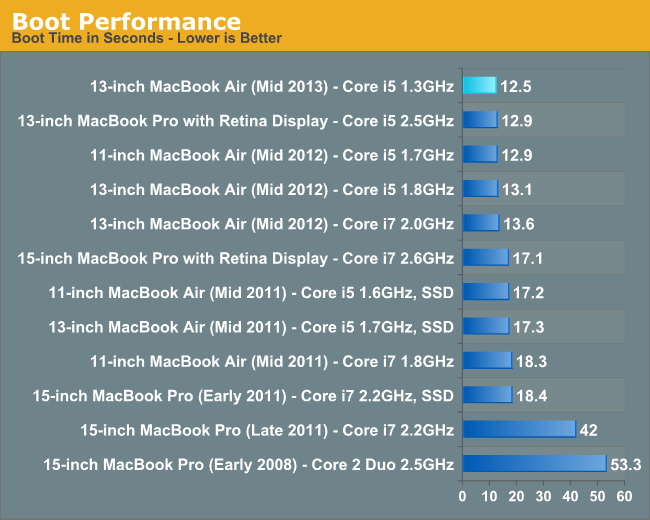
These next two charts look at single and multithreaded floating point performance using Cinebench 11.5. This test also gives us the rare opportunity of comparing to some older Mac Pro hardware as well from 2008 - 2010. Single threaded performance remains extremely important to overall system responsiveness, so it's always good to look at. As we found in our initial look at the new MBA, the 1.3GHz Core i5 CPU ends up performing about the same as last year's 1.8GHz part. I'd like to say it's all because of cooling and turbo boost, but in all likelihood Apple is trading some of Haswell's IPC gains for frequency here - enabling identical performance, at lower clocks thanks to Haswell's more efficient architecture.
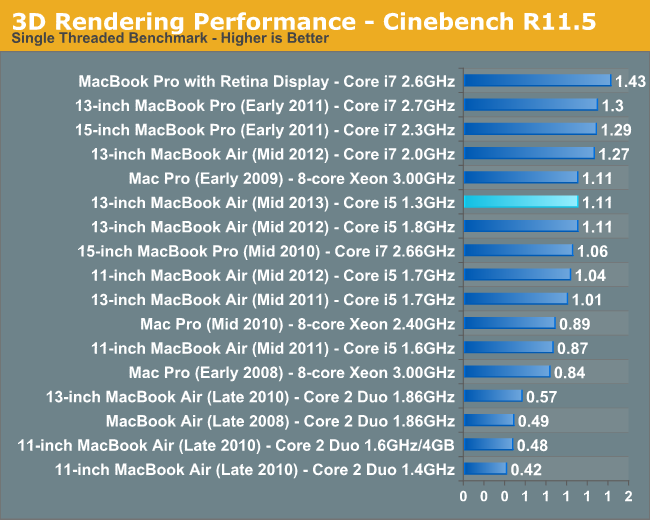
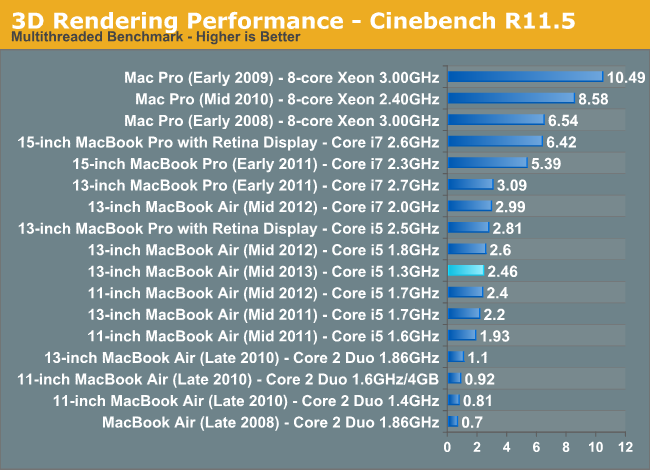
The multithreaded performance story is a bit different. The 1.3GHz i5 regresses in performance by about 5%. Overall performance is still quicker than the 2011 models, as well as the i7 based 11-inch MBA from 2012. Here we're simply seeing the 15W TDP limits come into play. Sharing both PCH and dual-core CPU power in a lower thermal footprint than last year's CPU alone is responsible for what we see above.
Video transcoding is really best suited for the higher end machines, but that doesn't change the fact that it's done on MacBook Airs as well. We'll start by looking at performance under iMovie. Here we're importing 1080p video from a Nikon D7000 and optimizing it during import.
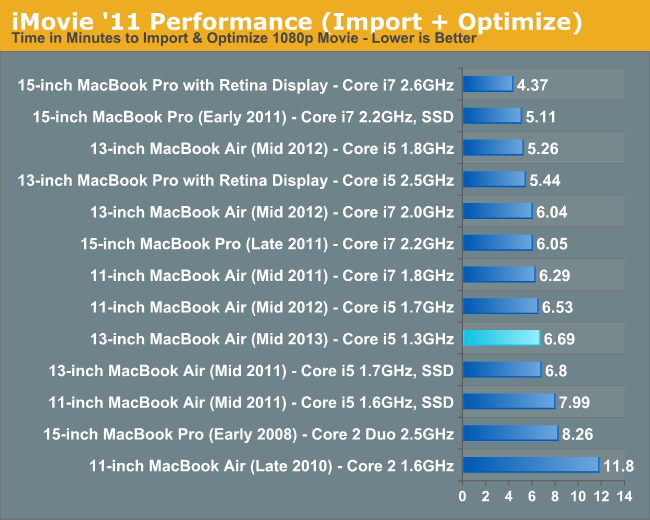
The 13-inch 1.3GHz Core i5 configuration performs similarly to last year's 11-inch 1.7GHz config. It's an interesting comparison because the 11-inch 2012 model is more thermally constrained than the 13-inch 2012 model, which is exactly what we see when we compare the 2013 13-inch MBA to the 2012 13-inch MBA. In this case the 2013 model is a hair quicker than the 2011.

We see a similar story for a full video export. The 1.3GHz 2013 MBA slots in behind the 2011 model in this CPU bound test.
Final Cut Pro X falls on the professional end of the video production spectrum. The test file is the same here, but the workload is far more strenuous.
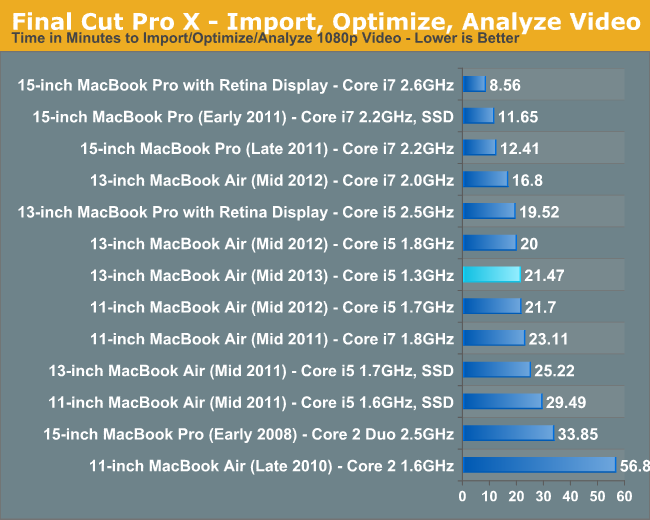
Once again, we see roughly the same performance from the 13-inch 2013 1.3GHz i5 as the 11-inch 2012 MBA. Here we do see substantially better performance than the 2011 models.
Our two photo workloads generally agree with what we saw in the video tests. The 1.3GHz Haswell part is definitely slower than th e previous generation 1.7/1.8GHz SKUs:
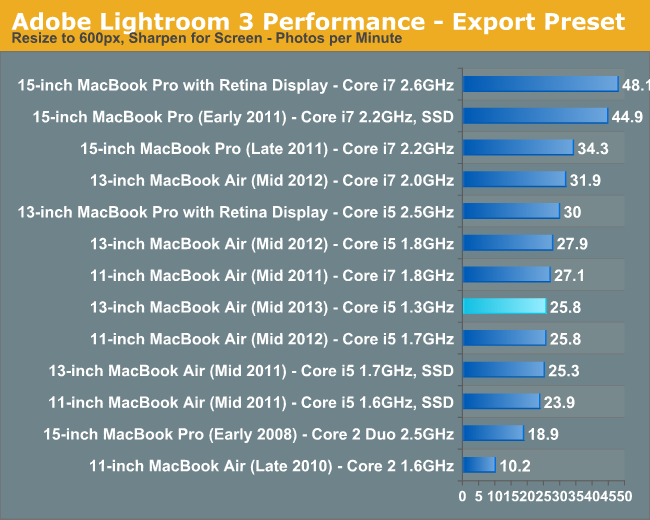
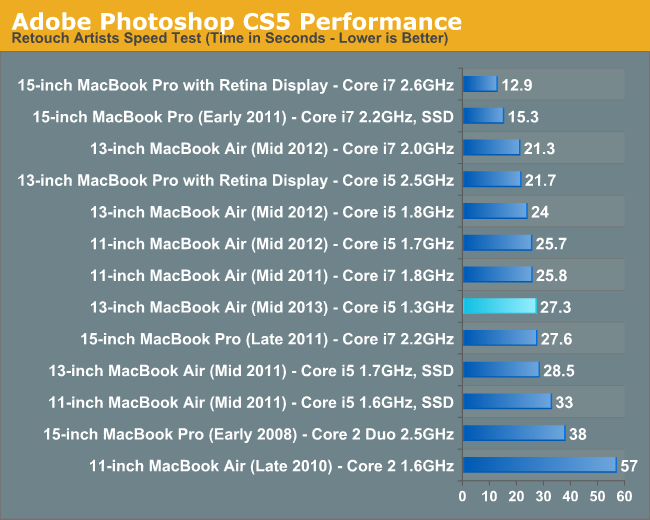
In our desktop review of Haswell I noted that performance in our compile test improved tremendously with the new architecture. As it's quite obvious that Haswell's IPC advantages don't surface all that much in our traditional suite, I wanted to see if perhaps things would be different in something that might lend itself better to Haswell's IPC improvements. I repeated our Firefox build test but under OS X. It's a multithreaded compile, with the number of threads set to 2x the number of cores (not threads) in a system. Unfortunately I came up with this bright idea while traveling, so I only had access to three machines: the 2013 13-inch MBA, the 15-inch rMBP and a 2GHz Core i7 2012 13-inch MBA. I'll add more results later, but I'm expecting this to be a part of our test suite going forward.

The combination of Haswell and a really fast SSD appears to help narrow the gap between the much higher clocked 2012 model and the base 2013 13-inch MBA. Here the faster Ivy Bridge CPU is less than 2% quicker. I'll reserve final judgements until I get my hands on the 1.7GHz Core i7 model, but my guess is this is an example of the best case scenario for Haswell where you get equivalent performance to a higher clocked Ivy Bridge part but with much better thermal/noise/battery life characteristics. For example, the fan was never audible on the 2013 MBA while running this test compared to running at a very noticeable volume on the 2012 Core i7 model. The same goes for temperatures. The i7 2012 model tends to run about 5% warmer along the bottom of the chassis compared to the 2013 i5.










233 Comments
View All Comments
smilingcrow - Monday, June 24, 2013 - link
Says the person complaining about other peoples' immature posts.darwinosx - Monday, June 24, 2013 - link
Most projectors use HDMI, VGA is long dead. You could have taken two seconds to Google VGA adapter for MacBook Air to find there are many options though. Putting a VGA port an an Air would be idiotic. Actually on any modern laptop.SirPerro - Monday, June 24, 2013 - link
VGA is dead already. LAN... Well, I haven't tried a WiFi connection that comes even close to wired. And that's not going to happen in the near future.Apple doesn't look to the future. Apple looks to the wallet. And certainly charging some serious money for cable adaptors which everybody else includes for free is a very good move towards their target.
And yes, if they removed RJ-45 because it was too thick, they could've used a 50c adaptor to a phisical smaller interface. But that wouldn't be so profitable.
Kevin G - Monday, June 24, 2013 - link
There plenty of space to put in an RJ-45 jack into the Macbook Airs if Apple didn't care about ascetics: in the bezel of the LCD display. Part of the Cat5 cable would go through the the RJ-45 hole in the display. I'd only work with the screen open but for a wired connection it wouldn't be much of an issue I believe. The problem is that this is a pretty fugly solution.darwinosx - Monday, June 24, 2013 - link
Ah so you are a laptop engineer..no...an adapter is fine for those who need it.Kevin G - Monday, June 24, 2013 - link
An adapter is easily lost.... the display only gets lost with the rest of the computer.AirieFenix - Thursday, June 27, 2013 - link
Putting a RJ45 connector on the bezel of the screen... yeah, I prefer to not comment.Spoony - Monday, June 24, 2013 - link
I work for a large corporation too. I know that projectors are all VGA, and everybody uses PowerPoint to show awful ugly presentations with slides just repeating what they say with zero value-add. Anything we can do to exit this model has my full support, and not shipping ANY laptop with VGA would be a great start.Don't make excuses for lame prehistoric corporate IT, demand better.
lilo777 - Monday, June 24, 2013 - link
Yeah. Marketing spin in this review was stronger than usual. Here are some examples."To hit an aggressive schedule, you have to mitigate risk." Really? Since when Apple's schedule has become aggressive? Launching 5 products per year which in most cases have very little changes. It's not like the previous version of MBA was released three months ago.
"We’re talking about TN panels (admittedly higher quality than most) and traditional pixel densities. Compared to the Retina Displays deployed across the rest of Apple’s product lines, these panels just aren’t as good. Compared to what you typically find elsewhere, they’re still among the best." "Typically find elsewhere"? Are they trying to compare MBA with $400 laptops? If you look at the same price range (Sony Vaio Pro, Samsung 9 etc.) you will find much better displays than what MBA has. It looks like being an Apple customer Anand has developed an attachment to the brand that interferes with the quality of his reviews.
darwinosx - Monday, June 24, 2013 - link
Everything you said is wrong and ignorant but the dumbest is accusing Anandtech of bias.